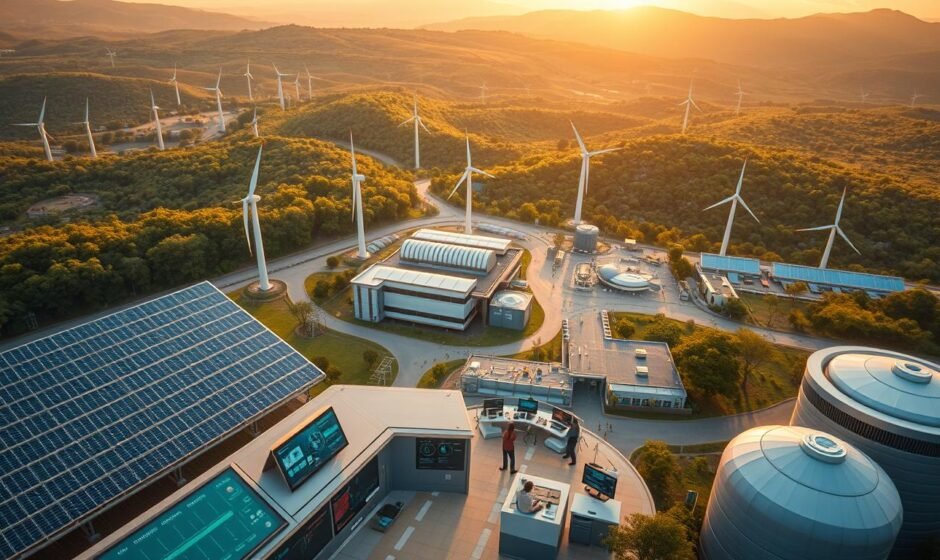Bill Gates once said, “We need an energy miracle.” AI in renewable energy management might just make this dream come true. AI can look at how much energy we use, guess how much we’ll need, and find ways to use less. For example, Google’s AI system cut the energy for cooling data centers by 40%.
Using AI for energy management can cut down on harmful emissions and shrink our carbon footprint. AI can guess how much energy we’ll need for things like heating and cooling based on the weather and how busy we are. This lets us make quick changes to use energy more efficiently. With AI in smart energy systems, we could see a 10-15% boost in energy use, making it a smart choice for businesses.
Key Takeaways
- AI applications in renewable energy management can reduce global energy consumption and lower carbon footprints.
- AI-driven energy management solutions can predict demand and optimize usage in commercial and industrial settings.
- Renewable energy AI solutions can decrease the cost of renewable energy systems by optimizing design and operation parameters.
- AI integration in smart energy systems can improve energy efficiency by 10-15%.
- AI applications in energy management have the ability to save utilities up to 20% in operational costs annually.
- AI can improve the accuracy of demand forecasting by 30% compared to traditional methods.
Introduction to AI in Renewable Energy
Exploring renewable energy, you’ll see AI’s big role. It’s changed how we use and save energy. AI makes solar and wind power work better, cutting down on waste and boosting performance.
AI has made energy systems smarter. It predicts energy needs and adjusts production. This makes energy use more balanced and efficient, easing grid pressure and cutting outage risks. AI also spots problems early, cutting downtime and making renewable energy more reliable.
- Improved efficiency and sustainability
- Enhanced predictive maintenance and reduced downtime
- Optimized energy consumption and reduced waste
- Increased reliability and grid stability
Companies like Google, IBM, and Tesla are changing energy management with AI. For example, Google’s AI cooling systems have cut data center energy use by over 40%. IBM’s AI helps keep the grid stable, preventing blackouts and managing energy in bad weather.
Benefits of AI Applications in Renewable Energy
AI is key in making renewable energy better and cheaper. It helps manage and forecast energy, making it more efficient and green. A report by Utility Dive shows AI can cut carbon emissions and support green growth.
AI brings many advantages to renewable energy. It optimizes energy storage, predicts demand, and adjusts usage. This cuts down on waste and emissions. AI also boosts system efficiency by spotting and fixing problems before they happen, saving on costs.
On Renewable Vibes, it’s mentioned that AI finds the best spots for solar and wind farms. This leads to better installations and more energy.
- It makes energy use more efficient and sustainable.
- It lowers costs with new AI tech.
- It makes the grid more stable and reliable.
- It cuts downtime with predictive maintenance.
Using AI in renewable energy helps companies be greener, save money, and support a sustainable future.
AI Technologies Empowering Renewable Energy
Exploring renewable energy shows how AI technologies boost efficiency and sustainability. Machine learning for renewable energy management is key in predicting energy needs and improving how we use it. AI helps manage energy in real-time, making things work better and saving money.
Predictive Analytics and IoT Integration
Machine learning algorithms in predictive analytics help forecast energy demand accurately. This lets utilities adjust their energy production. IoT integration adds real-time data from sensors and smart meters. This data helps optimize energy distribution and cut down on waste.
Benefits of AI-Powered Renewable Energy Management
The advantages of AI in renewable energy management are clear:
- It makes things more efficient and sustainable.
- It cuts costs through better maintenance and energy use.
- It makes the grid more reliable and resilient.
AI technologies, including machine learning for renewable energy management, bring big improvements. The renewable energy sector sees better efficiency, sustainability, and cost savings.
Smart Grid Integration with AI
Exploring renewable energy AI solutions is key. Smart grid integration is vital for better energy distribution. AI technology boosts energy management efficiency. For example, renewable energy sources can be added to the grid. This makes energy supply more sustainable and reliable.
Smart grid integration with AI offers many benefits. AI can manage real-time data and predict energy demand. This prevents blackouts during sudden energy spikes. AI also flags grid failures early, saving time and money on repairs.
Some main advantages of smart grid integration with AI are:
- Lower operational costs with fewer manual actions
- Higher energy efficiency through better management
- More reliable energy and fewer blackouts
Thinking about smart grid integration with AI is important. Renewable energy AI solutions play a big role in optimizing energy distribution. AI helps make energy supply sustainable and reliable. It optimizes energy distribution, predicts demand, and adjusts production to reduce waste and boost efficiency.

AI for Energy Storage Management
Exploring renewable energy shows how key efficient energy storage is. AI helps manage this by predicting energy needs and adjusting how energy is stored. This cuts down on waste and boosts efficiency.
Machine learning is a big part of this. It looks at data from different places to make energy storage better.
Predictive analytics help guess how much energy will be needed. This lets energy storage systems work better. Machine learning uses past data and current info to make these predictions.
Using AI for energy storage brings many benefits. It makes energy use more efficient, lowers costs, and keeps the grid stable. Optimizing energy storage helps the grid during busy times, cutting down on power outages and emissions.
Renewable Energy Forecasting with AI
Exploring renewable energy means looking at AI’s role in forecasting. Accurate predictions are key for a stable grid and reliable energy. AI helps by analyzing data from weather, energy use, and more.
The U.S. aims for 100% clean electricity by 2035. AI is vital in this effort. It optimizes energy, cuts waste, and boosts efficiency. For example, AI can forecast demand and adjust production, avoiding excess or shortage.
- More accurate weather forecasts
- Better demand and supply forecasting
- Optimized energy production and distribution
- Less energy waste and better efficiency
Using AI in renewable energy management keeps you ahead. It helps make smart energy choices. With AI, you can build a greener, more efficient energy system, using less fossil fuels and cutting carbon emissions.
Case Studies: AI Transforming Renewable Energy
Looking into AI’s role in renewable energy, it’s key to see how top companies are doing it. Google and Verdigris Technologies have cut energy use and costs a lot. They use AI to make energy use better by looking at sensor data and tweaking settings.
AI helps make renewable energy grids more stable and cuts downtime. Studies show AI can cut downtime by 70%. This is big, given the renewable energy market is set to grow a lot. For more on renewable energy and AI, check out renewable energy platforms for insights and advice.
AI brings many benefits to renewable energy projects. It boosts solar energy efficiency by 20% and productivity by 25%. AI also cuts risks and downtime in energy work by up to 70%. Here are some main benefits of AI in renewable energy:
- Improved efficiency and sustainability
- Cost reduction through AI innovations
- Enhanced grid stability and reliability
Exploring AI’s role in renewable energy is vital. AI can help use energy better, cut costs, and make grids more stable. This all helps make our future more sustainable.
Challenges in Implementing AI Technologies
When you think about using AI for renewable energy, you might face some hurdles. One big worry is keeping data safe and private. Retrofitting legacy equipment with AI can be tricky, and protecting sensitive data is key. Only 12% of energy companies have adopted advanced AI, but 73% are exploring or planning to.
Another big issue is making old systems work with new AI. Setting up a new SCADA system can take 10 years. And, some energy grid equipment is 30 to 80 years old. Companies like DNV are working on guidelines for using AI in energy and other sectors.

- Data privacy and security concerns
- Technological barriers in integration
- High costs associated with implementing new AI technologies
To beat these challenges, a smart plan is needed. Focus onmachine learning for renewable energy managementandAI applications in renewable energy management. This way, you can make AI work well for your business.
The Future of AI and Renewable Energy Management
The use of AI technologies is changing how we handle renewable energy systems. It helps us use energy better, cut costs, and make the grid more stable. It also improves how we forecast energy needs.
Looking to the future, we’ll see more upcoming trends in AI for renewable energy. Machine learning and predictive analytics will keep helping us guess energy demand and avoid failures. The integration of AI and IoT will also let us monitor and make smart decisions in real-time.
But, for AI in renewable energy management to work well, we need the right policy. Governments must support the use of AI technology and make sure it’s used ethically. They need to focus on data privacy, set up cybersecurity rules, and be open about AI algorithms.
With AI and good policies, the future of renewable energy management looks bright. It will be more efficient, sustainable, and affordable. This will help our economy grow and fight climate change, leading to a greener future.




